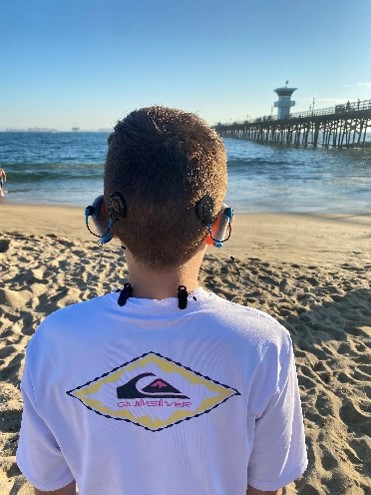The fall season brings sweater weather, the debate around a certain flavor of coffee and our kids going back to school. Rita is one of our Recipient Solutions Managers, a credentialed Teacher of the Deaf and – most importantly – a mom to Evan, a 7th grader with a cochlear implant. Rita answers 5 commonly asked questions to help kids get back to school with a cochlear implant.
1. If a child is mainstreamed in their neighborhood school, what are the steps to making sure the new teacher knows what to expect?
Consider having a training in-service meeting to provide information to the teacher before the school year begins. This meeting not only helps new teachers know what to expect but is also a great time for students to introduce themselves. This can be done by a parent or caregiver, a Teacher of the Deaf, an Educational Audiologist or even the student, depending on their age and comfort level. In either case, having the student present can be impactful. Teacher-friendly user guides are also helpful for teachers to understand the equipment in case of any troubleshooting needs that may arise throughout the school year. Teacher guides can be found on our website along with additional rehabilitation information for all ages.
2. What is the right age to think about teaching a student to advocate for himself or herself at school? What might that look like?
Advocacy can begin at any stage. An important skill for younger students is being able to report detection. For example, teaching a preschooler to communicate whether their device is on or off is a good start. For older students, advocacy might include introducing them to more detail about how their devices work. This may help them become comfortable with explaining their hearing loss and devices to others. It is never too early to begin thinking about advocacy and practicing at home is helpful. It can teach a child to understand not only when to ask for help, but how. Demonstrating or modeling by a caretaker can help children understand what they need to do in situations where they might need help. Older teens should definitely be practicing self-advocacy in high school. This is a great time to learn some independent skills in preparation for life beyond graduation. In addition to the resources for our youngest recipients, there is a section dedicated to teens heading back to school with a cochlear implant in the rehabilitation section of our website.
3. What happens if a sound processor stops working during the school day?
If a processor stops working during the school day, chances are it may be due to battery life. A great way to ensure a child is never out of sound is to keep their disposable batteries and the case/holder in their backpack. Although the teacher may have an understanding of how to replace a battery, ensuring your child is familiar with the process as well could be helpful in this situation.
4. At what age do children start to use assistive listening devices in the classroom, like the Mini Microphone 2+ or Roger FM for example?
Hearing assistive technologies can be used as early as pre-school and I would encourage families to start there. With the Mini Microphone 2+, children can hear more clearly in any listening situation, especially noisy environments.12
It is imperative that children who are learning language and developing their listening abilities receive a clear signal. This relieves their cognitive load and helps reduce listening fatigue. Going back to school with a cochlear implant can be challenging, so making the teacher’s voice as easy to hear as possible can make a real difference.
5. My child is transferring from a preschool for children who are deaf and hard of hearing into a mainstream classroom. How do you suggest introducing the other children to the cochlear implant and sound processor?
Depending on the student and their comfort level, a class presentation by the student and/or their Teacher of the Deaf may be helpful. Another great way to help other children understand hearing loss and why a cochlear implant is important is by reading a book with a character who wears devices to the class. A shy child may find it hard to bring attention to the matter so if a student prefers not to have a presentation or a book sharing, practicing a response about what to say when others ask about their devices can serve as helpful.
Check out our rehab resources and feel good about heading back to school with a cochlear implant!
- Jones, M (2017, July) Hearing in Noise Benefit Using the Cochlear Mini Microphone 2+ with Nucleus Sound Processors, CI2017 Pediatric15th Symposium on Cochlear Implants in Children,San Francisco, CA
- Razza, S., Zaccone, M., Meli, A., & Cristofari, E. (2017). Evaluation of speech reception threshold in noise in young Cochlear™ Nucleus ® system 6 implant recipients using two different digital remote microphone technologies and a speech enhancement sound processing algorithm. International Journal of Pediatric Otorhinolaryngology, 103, 71-75. doi:10.1016/j.ijporl.2017.10.002


